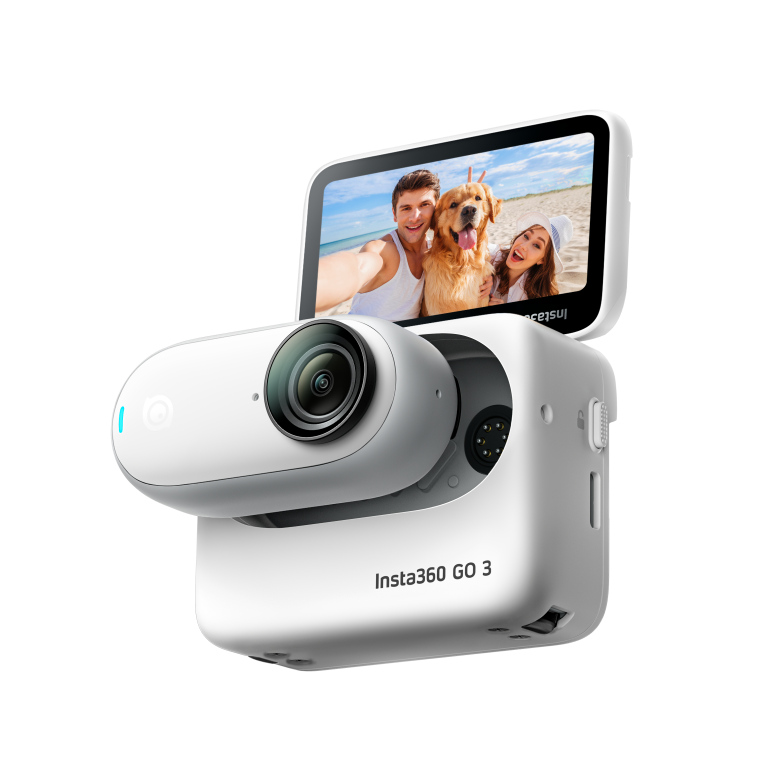Insta360, as its company name suggests, began life as maker of cameras that shoot 360-degree videos. And while its flagship product can still do that, Insta360 is now best known as the maker of some of the best action cameras, and it’s not hard to see Insta360 cameras in the hands of extreme sports athletes.
The Go 3, the third generation in the company’s tiny thumb-sized action camera should be another must-carry item for adventurers—though it has crept up both in size and retail price.
The Insta360 Go 3 starts at $380 for the base 32GB storage model and jumps up to $430 for the 128GB storage. This is quite a bump up from the $300 price of the Go 2, but the Go 3 can do a lot more.
The Go 3’s core camera is still similar to the first two generations: it’s an oval camera slightly larger than a human thumb that can capture video or snap photos. Due to the small size of the camera and its magnetic back, it’s very easy to attach it to things, including unusual spots, for some unique perspectives. The Go 3 is chunkier than the first two generation, but it’s also because the camera sensor got better and bigger. The Go 3 can shoot videos up to 2.7k and in landscape or portrait orientation, while the original Go topped out at 1080p.
But the biggest upgrade comes in the casing. The original Go had a case that would house and charge the camera but not do much else. The second generation Go case included physical buttons and small tripod legs so it can be used to control the cameras. The Go 3’s case, well, as you can see from product photos, has become a full-blown GoPro like body with a 2.2-inch flip out screen. This means when the Go 3 is housed in the case, it behaves like a conventional GoPro style action camera.
When you consider that the Go 3 has newer and better camera sensors, larger battery, and the addition of a 2.2-inch screen in the case, then an extra $80 is perhaps justifiable.
The Go 3’s video footage isn’t better than a smartphone’s camera footage, but it shoots at a wider, more sweeping field of field and it has much better stabilization. So this is an excellent camera for people who want to document their activity, whether it be cycling, skateboarding, or something more extreme like skydiving.
The Go 3’s retail package includes some useful accessories to help mount the cameras. There’s a magnetic pendant that a user can wear around their neck, and onto which the Go 3 can stick. This is for capturing first-person perspective videos. The T-shaped mounting bracket with a quarter-inch screw mount allows it to be put onto selfie sticks or tripods. There’s also a hat or clothing clip, and yet another holder that sticks to flat surfaces.
These accessories open up a world of possibilities in terms of where you can shoot. In the video below, you can see I’ve placed the Go 3 in a series of unusual spots, like inside a refrigerator, or very high up on a street sign, inside a bag of chips.
New to the Go 3 software is “FreeFrame” video, which allows you to shoot first, and then later choose between exporting the video to either landscape or portrait format. This saves a lot of time for people who want to reuse the same clip for both vertical video formats (Instagram or TikTok) and conventional widescreen format (YouTube).
The camera can operate independently from the case, so you can control the camera from afar with the case, and even preview the footage using the 2.2-inch screen. The addition of a screen is a game changer for the Go series, as previously, you couldn’t see your footage until after the fact. Battery life is good, allowing the camera to shoot about 40 minutes on a single charge, but the case adds another four charges.
While I really like the Go 3, I do think it has lost some of the ultra-portability of the first two cameras. The Go 3 camera by itself at 35g is still very, very light. But the case with the screen weighs 96.3g, so combined it’s now a package that weighs 130-ish grams and measures 63.5 x 47.6 x 29.5mm. It basically feels like a GoPro.
It’s no longer small enough that you can have in your pant pocket and not notice it (which was the case with the first two Go models). It’s also just big enough that you probably need to make the conscious decision to either leave it at home or take it with you when you go out, whereas the first two Go were so small, I’d just leave it in my backpack full-time, or leave it in a shirt pocket all day when I’m out. This opens up the possibility of me using the camera when I wasn’t expecting to do so. With the Go 3, it feels more like, an active decision you make about whether you need to take the camera out.
Read the full article here










